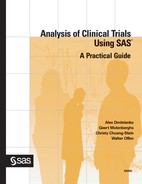Book Description
This comprehensive guide bridges the gap between modern statistical methodology and real-world clinical trial applications. Step-by-step instructions illustrated with examples from actual trials and case studies serve to define a statistical method and its relevance in a clinical trials setting and to illustrate how to implement the method rapidly and efficiently using the power of SAS software. Topics reflect the International Conference on Harmonization (ICH) guidelines for the pharmaceutical industry and address important statistical problems encountered in clinical trials, including analysis of stratified data, incomplete data, multiple inferences, issues arising in safety and efficacy monitoring, and reference intervals for extreme safety and diagnostic measurements. Clinical statisticians, research scientists, and graduate students in biostatistics will greatly benefit from the decades of clinical research experience compiled in this book. Numerous ready-to-use SAS macros and example code are included.
Table of Contents
- 1 Analysis of Stratified Data
- 2 Multiple Comparisons and Multiple
- 3 Analysis of Safety and Diagnostic Data
- 4 Interim Data Monitoring
- 5 Analysis of Incomplete Data
- 5.1 Introduction
- 5.2 Case Studies
- 5.3 Data Setting and Modeling Framework
- 5.4 Analysis of Complete Growth Data
- 5.5 Simple Methods and MCAR
- 5.6 Available Case Methods
- 5.7 Likelihood-Based Ignorable Analyses
- 5.8 Multiple Imputation
- 5.9 The EM Algorithm
- 5.10 Categorical Data
- 5.11 MNAR and Sensitivity Analysis
- 5.12 Summary
- Appendix
- References
- Index
